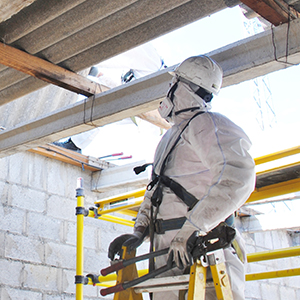YOUR STEP BY STEP GUIDE
In the realm of construction, demolition stands as a pivotal precursor to progress. The process of residential demolition, while initially daunting, can be navigated with finesse and efficiency through a clear understanding of its intricate steps and methodologies. Welcome to our comprehensive guide, where we dissect the nuances of residential demolition, equipping you with the knowledge necessary to embark on your project with confidence.
Preparing for Demolition
Before the first swing of the wrecking ball, meticulous preparations lay the groundwork for a seamless demolition endeavor. Segmenting and preparing for demolition involve a series of critical steps aimed at ensuring safety, efficiency, and environmental responsibility.
 Identifying Hazardous Materials
Identifying Hazardous Materials
Hazardous materials lurking within residential structures pose significant challenges and risks. Asbestos, lead paint, and mold are among the notorious culprits demanding vigilant attention.
- Asbestos: A silent threat commonly found in insulation and construction materials, asbestos mandates professional inspection and removal to prevent airborne contamination.
- Lead Paint: Residing within structures predating 1978, lead paint necessitates meticulous inspection and proper abatement to avert health hazards, particularly for vulnerable demographics.
- Mold: Infesting environments with its insidious presence, mold requires expert remediation to forestall health complications and environmental contamination.

 Salvaging Reusable Materials and Recycling
Salvaging Reusable Materials and Recycling
Amidst the rubble lies the potential for resource conservation and sustainable practices. Salvaging reusable materials and recycling constitute integral facets of responsible demolition practices.
- Wood: Flooring, beams, and doors harbor latent potential for repurposing in subsequent construction endeavors or as bespoke furniture pieces.
- Metal: From pipes to roofing materials, metal components present ripe opportunities for recycling into novel creations, minimizing waste and maximizing resource utilization.
- Glass: The transparency of glass extends beyond its physical form, offering avenues for repurposing or recycling into innovative products.
- Fixtures: Sinks, toilets, and light fixtures, while seemingly mundane, can find renewed purpose in alternate projects, mitigating waste accumulation and fostering resource efficiency.
 Techniques in Home Demolition
Techniques in Home Demolition
Dismantling residential structures demands finesse and precision, with various methodologies tailored to distinct scenarios. Let’s delve into three primary techniques employed in residential demolition:
Mechanical Demolition
Harnessing the raw power of machinery, mechanical demolition reigns as a ubiquitous method for dismantling homes and small buildings. Excavators, bulldozers, and wrecking balls converge to orchestrate a symphony of deconstruction, rendering structures to rubble with calculated force.
Selective Demolition
Where precision is paramount and salvaging takes precedence, selective demolition emerges as the method of choice. By disassembling structures meticulously, piece by piece, salvageable materials are reclaimed, waste is minimized, and environmental stewardship takes center stage.
 Explosive Demolition
Explosive Demolition
In scenarios demanding expedited deconstruction or intricate structural considerations, explosive demolition emerges as a formidable option. Through strategic placement of explosives, structures succumb to controlled implosion, paving the way for rapid clearance of vast expanses with surgical precision.
Post-Demolition Cleanup and Evaluating Performance
With the dust settled and debris dispersed, post-demolition cleanup assumes prominence in restoring order and mitigating environmental impact.
Debris Removal and Disposal
A choreographed effort of sorting and segregating the debris ensues, as the remnants are meticulously sorted for recycling or disposal. Concrete, metals, plastics, wood, and furniture undergo scrutiny, with recycling initiatives championed to minimize waste and maximize resource efficiency.
Environmental Impact and Consequences
Beyond the realm of structural deconstruction lies a tapestry of environmental considerations, each thread weaving a narrative of accountability and stewardship. Noise pollution, airborne contaminants, chemical dispersal, and erosion management stand as focal points in mitigating adverse repercussions.
Role of Demolition Professionals
At the vanguard of residential demolition stand seasoned professionals, such as Wreck-It Demolition, entrusted with the mantle of safety, efficiency, and regulatory compliance. Exploiting state-of-the-art technology and tested methodologies, we navigate sensitive landscapes with surgical precision. The result is an alliance between environmental consciousness and resource conservation.
Handling Hazardous Materials
In the process of dismantling a structure, hazardous materials such as asbestos, lead paint, and other toxic substances are often encountered. Demolition professionals adhere to strict protocols for identifying, removing, and disposing of these materials safely. This not only protects the environment but also ensures the safety of workers and surrounding communities.
Minimizing Waste
The traditional approach of demolishing structures often resulted in large amounts of waste being sent to landfills. However, with advancements in recycling techniques and awareness of sustainable practices, demolition companies now prioritize minimizing waste. Salvaging materials such as wood, metal, and concrete not only reduces waste but also saves resources.
Safety Precautions
Demolition is a highly specialized field that requires extensive training and expertise. Safety precautions are of utmost importance to protect both workers and the public. Demolition professionals undergo rigorous safety training and adhere to strict regulations set by governing bodies such as OSHA (Occupational Safety and Health Administration). This includes wearing personal protective equipment, executing controlled demolitions, and implementing emergency response plans.
Environmental Impact
The demolition process has a direct impact on the environment through air emissions, noise pollution, water runoff, and disposal of waste materials. To mitigate these impacts, demolition companies use environmentally-friendly techniques such as dust control measures
Procurement of Permits and Licenses
Navigating the labyrinth of legalities, procurement of permits stands as the initial step towards legitimizing demolition endeavors. Compliance with local regulations, adherence to building codes, and maintenance of licensure and insurance underscore the commitment to professionalism and integrity.
Conclusion
In the grand tapestry of construction, residential demolition emerges as a pivotal chapter, bridging the chasm between the old and the new. Armed with knowledge and guided by prudence, embark on your demolition journey with confidence, knowing that each swing of the wrecking ball paves the way for transformative progress. Contact Wreck-It Demolition today to embark on your demolition odyssey, where professionalism, proficiency, and environmental stewardship converge in a harmonious symphony.

